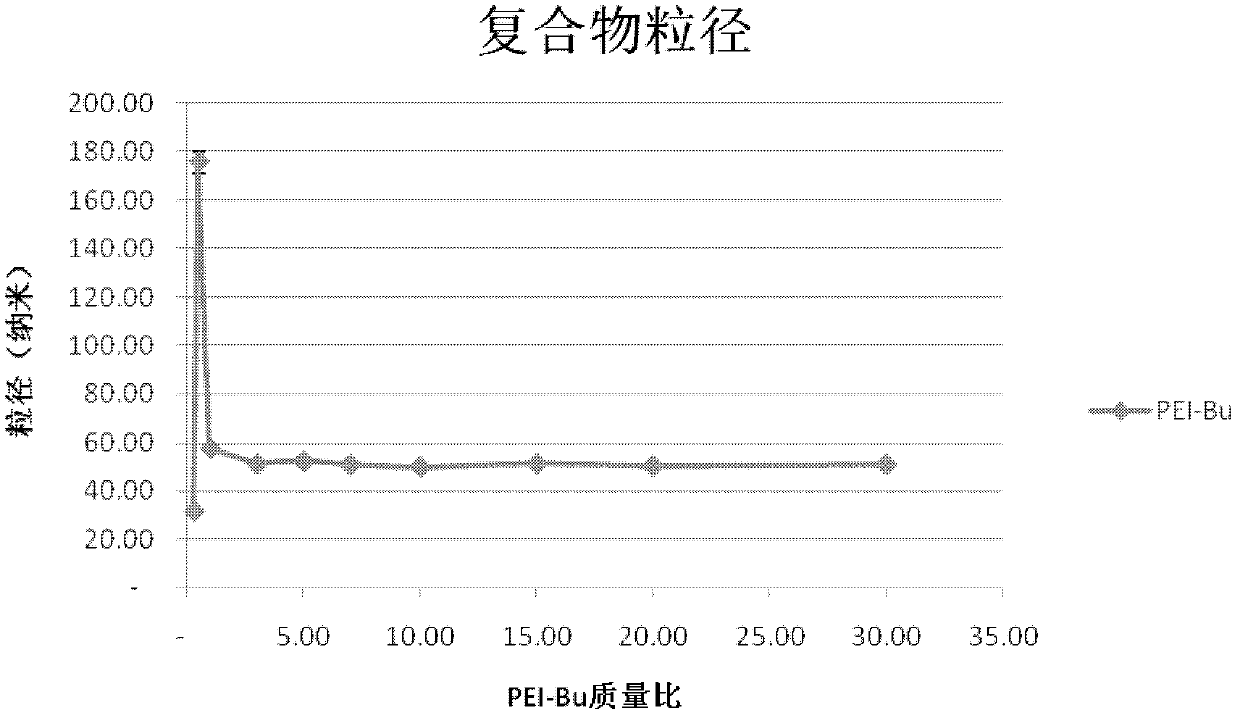Preparation process of ammonia-ester-bond cross-linked poly(ethylene imine) polycation carrier
A technology of polyethyleneimine and urethane bonds, applied in the preparation and purification of small molecular weight PEI cross-linked derivatives, can solve the problems of high transfection activity, high toxicity, toxicity, etc., and achieve significant cell survival rate and low toxicity Effect
- Summary
- Abstract
- Description
- Claims
- Application Information
AI Technical Summary
Problems solved by technology
Method used
Image
Examples
Embodiment 1
[0034] PEI with a molecular weight of 800Da reacted with 1,4-butanediol dichloroformate at a molar ratio of 3:2. Calcium hydride was added to chloroform and triethylamine respectively, and then heated to reflux for 2 hours under the protection of high-purity nitrogen, and fresh fractions were collected for later use. Dissolve PEI800 and 1,4-butanediol dichloroformate in chloroform, respectively, and make the two into 3mL and 20mL solutions under anhydrous and oxygen-free conditions, and the reaction is carried out under ice bath conditions. The chloroform solution of PEI800 was added, and then 2.5 times excess triethylamine was added, and the chloroform solution of 1,4-butanediol dichloroformate was added dropwise to the reaction system under anhydrous and oxygen-free conditions to react for 24 hours. After the reaction was stopped, most of the organic solvent was removed with a rotary evaporator under reduced pressure and temperature, and then the obtained crude product was d...
Embodiment 2
[0036] Determination of Polymer Molecular Weight by Gel Permeation Chromatography (GPC)
[0037] Polyethylene glycol (PEG) standard and PEI-Bu as samples were dissolved in pure water to obtain a 10 mg / ml solution, shake well and stand still, then filter with a 0.45 μm microporous membrane, take the filtrate, and inject 20 μl , record the chromatogram. The logarithm value lgMw of the weight-average molecular weight of PEI standard substance and corresponding retention time (tR) are carried out linear regression, obtain regression equation. The molecular weight and distribution of PEI-Sc samples are calculated by the following formula:
[0038] Mn=∑RIi / ∑(RIi / Mi);
[0039] Mw=∑(RIi Mi) / ∑RIi;
[0040] D=Mw / Mn;
[0041] In the above formula, Mn and Mw are respectively the number average molecular weight and the weight average molecular weight; D refers to the distribution coefficient; RIi is the peak height of the test sample at the retention time i; Mi is the molecular weight ...
Embodiment 3
[0043] Preparation of Polymer (PEI-Bu) and Plasmid Complex (Polyplex)
[0044] Weigh a certain amount of polymer, add ultrapure water to make a 2mg / mL solution, then filter it with a 0.22μm sterile filter head, dilute the plasmid concentration to 1mg / mL, and prepare complex solutions with different mass ratios. The concentration of the plasmid solution remains the same, then dilute the concentration of the polymer solution according to different mass ratios, pay attention to keep the volumes of the diluted polymer solution and the plasmid solution equal, and finally add the polymer solution to the plasmid solution quickly and mix, at room temperature After incubation for 20 min, a series of complexes with mass ratios are obtained, which can be used for further determination of physical and chemical properties.
PUM
 Login to View More
Login to View More Abstract
Description
Claims
Application Information
 Login to View More
Login to View More - R&D
- Intellectual Property
- Life Sciences
- Materials
- Tech Scout
- Unparalleled Data Quality
- Higher Quality Content
- 60% Fewer Hallucinations
Browse by: Latest US Patents, China's latest patents, Technical Efficacy Thesaurus, Application Domain, Technology Topic, Popular Technical Reports.
© 2025 PatSnap. All rights reserved.Legal|Privacy policy|Modern Slavery Act Transparency Statement|Sitemap|About US| Contact US: help@patsnap.com



